By Lorna Bointon, Sea Watch Foundation Regional Coordinator
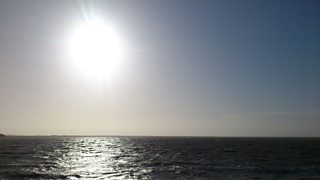
The sea is ever-changing. Image by R. Bointon
After a long absence, we have embraced freedom and revelled again in shared experiences. Throughout the summer, there have been natural spectacles to witness along our shorelines. From watching oystercatchers poking their long beaks among seaweed covered rocks, to sea gooseberries washed in by the tide, glistening on the wet sand just out of reach of the frothy receding waves. Some sea watchers have been lucky to glimpse their first dorsal fin breaking the water or to watch the mesmerising rolling motion of foraging porpoises as gannets dive greedily in a feeding frenzy and gulls cry noisily overhead. Some of us have strolled along sea-sprayed cliffs and rocky shores as pairs of red-legged choughs free-fall in a courtship dance above our heads. Others may have had the pleasure of spotting seals lazily resting in the calm sea amid bobbing guillemots and cormorants as kittiwakes scream overhead. Among all this, the sulphurous aroma of seaweeds and algae has pervaded the air as hardy plants kissed by the salty breeze push through the shingle and cling to rocks.
And now, with a final ‘hurrah’ summer fades into autumn amid a flourish of rich hues. The sea reflects the changing colour of the sky from icy gun-metal grey as ominous storm clouds gather, to molten gold on gentle serene evenings as the sun dips beyond the horizon with a final brilliant flash.

The sea can change in an instant subject to the weather and time of year. Image by R Bointon
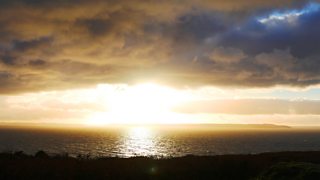
The sun sets earlier with a blinding flash as it dips below the horizon. Image by R Bointon
Hue and cry
There is always something to see and hear along our coastline, from seabirds wheeling overhead to birds foraging along the shoreline, making their presence known with their high pitched peeping calls. During the autumn months we can still enjoy a spectacle of colour, from drifts of seaweed draped along the shoreline poked by inquisitive beaks of turnstones and oystercatchers. Some foraging birds masquerade effectively as rocks, with only a flash of orange leg or beak to give away their presence.
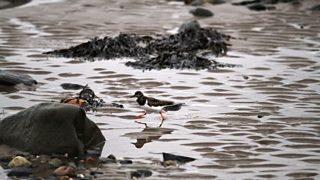
Turnstone in winter plumage (Arenaria intepres). Image by R Bointon
Look out for the iridescence plumage of migratory starlings as they gather in numbers to roost along the undersides of seaside piers or bridges. You may be lucky to see them perform a spectacular murmuration as they fly in unison in constantly swirling aerial formations before dropping from the sky to safety.

Starling (Sturnus vulgaris). Image by R. Bointon
Fade to grey
In this time of dormancy or hibernation, as leaves fall and plants wither ready for renewal the following spring, most animals seek to store food and find shelter to slumber peacefully through the harshest of weather.
But the autumn period isn’t just about hunkering down for the colder months. Colour changes and renewal are happening elsewhere.
The coats of grey seals display a variety of colours and patterns from different shades of grey through to various pale or dark brown colours. As they mature coats may darken in colour but individual seals can be identified by their markings.
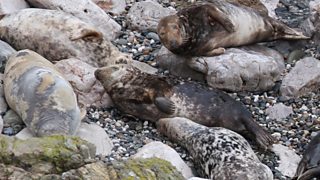
Between a rock and a hard place? Image by R. Bointon
Seals are sexually dimorphic which means that there are differences between the sexes. Larger than the females, with a larger head and thicker neck, male seals, known as bulls, are also darker than female cow seals with less mottling.
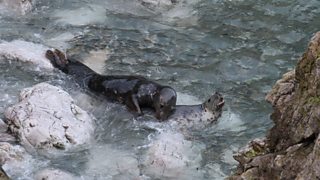
Fifty shades of grey. Image by R Bointon
The coat of a grey seal is referred to as its pelage.
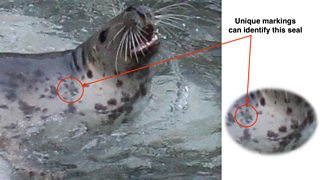
‘Pelage’ refers to the hair, fur or wool of an animal. Image by R Bointon
The pelage of grey seals is variable with some exhibiting many spots and patches whilst others have only a small amount. Each seal has a unique coat pattern of blotches and spots that can be used to identify individuals.
Ideally, a photo of the head and neck on right and left side is best for identification
The markings may look different when wet or dry and during the annual moult (also juvenile male coats become more uniformly dark with age).
Grey seals start to pup around the end of August and the pups are born with a white coat, or lanugo, which they moult as they are weaned and become independent.
Please practice responsible seal watching; remember to always keep a good distance away from seals (more than 100 meters is best) and to keep dogs on leads as these actions lessen the likelihood of disturbance to the seals which can threaten their survival especially in the pupping season.
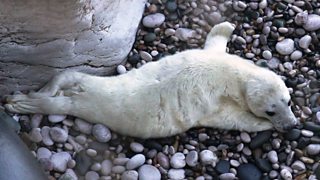
A whiter shade of pale. Image by R Bointon
Golden opportunity
Bottlenose dolphins can be seen around our coastline throughout the year. There’s always the chance that a seaside stroll will result in a magical moment when you spot a curved dorsal fin breaking the surface.
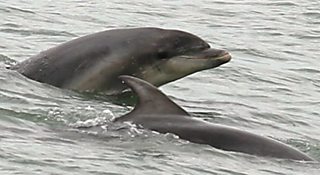
Bottlenose dolphins may appear brown or grey depending on the light. Image by R. Bointon
You can get involved by becoming one of our valued observers, observing and recording cetaceans and seals around the UK coast, by downloading the .
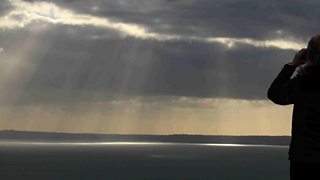
Whatever the season, you can help by becoming a regular observer. Image by R Bointon
The valuable data gathered through the patience and efforts of our volunteers will help in supporting, conserving and protecting cetaceans around our coast. Recording their presence is vital for our knowledge of distributions, movements, habitats and human pressures so that we can help conserve and protect them in our waters.
By Lorna Bointon, Sea Watch Foundation Regional Coordinator
